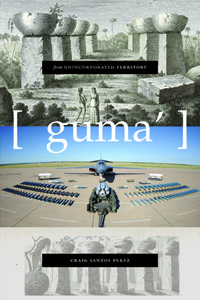by Meagan Wilson, Colorado Review Editorial Assistant
 Craig Santos Perez is a native Chamoru (Chamorro) from the Pacific Island of Guåhan (Guam). He is the author of three collections of poetry, most recently from unincorporated territory [guma’], winner of the American Book Award. He is an associate professor in the English Department at the University of Hawai’i, Mānoa. Craig graciously agreed to an extended conversation around both [guma’] and documentary poetry. Our email exchange follows:
Craig Santos Perez is a native Chamoru (Chamorro) from the Pacific Island of Guåhan (Guam). He is the author of three collections of poetry, most recently from unincorporated territory [guma’], winner of the American Book Award. He is an associate professor in the English Department at the University of Hawai’i, Mānoa. Craig graciously agreed to an extended conversation around both [guma’] and documentary poetry. Our email exchange follows:
Meagan Wilson: I remember finding your blog at about the same time I graduated from college in 2006, and your voice was a refreshing change from many I’d read before. And now I’m experiencing that again in reading from unincorporated territory [guma’] in Camille Dungy’s Docupoetics course. Maybe we can begin by talking about voice in conjunction with docupoetry: what possibilities or limitations for voice—whether the voice of the poet or those of others—do you see in a documentary poem that might not be otherwise available or effective?
Craig Santos Perez: To me, voice is an important element of docupoetics. Voice insists on the personal and the human within historical, political, cultural, and everyday documents and/or the documentation the past and the present. In my own work, this means foregrounding my own voice (thoughts, emotions, and perceptions) on a given topic, or the voices of my family whose lives were shaped by larger colonial forces that I am documenting. Part of this impulse is decolonial in the sense that our indigenous voices are often ignored or silenced in the documents and documentations of Guam history. Whereas the lyric is driven by voice, the docupoem emplaces voice within the historical and textual materiality of other contexts—highlighting the tension between voice and historiography.
MW: That insistence on the personal is so crucial, and in reading from unincorporated territory I’m constantly impressed by how you handle that personal relationship to the larger context in which you’re working, that foregrounding of the individual body and voice, “that re-territorializing the Chamorro language in relation to my own body, by way of the page,” as you write in [hacha].
Along those lines, this is a poetics of negotiation and reclamation. How do you consider that negotiation between Chamorro and English, as in, how do you feel these languages in conversation with one another on the page? The languages both seem in constant re-definition . . . in conceptual or perhaps technical terms, how do you handle the tension that arises there?
CSP: While I grew up in a bilingual family, my education in American colonial schools on Guam was entirely in English, and the entire public sphere was dominated by English. I never had the opportunity to study Chamorro language or develop any kind of written fluency. When my family migrated to California, and when I left my family to attend college, Chamorro became nearly non-existent in my life. Because poetry became a way for me to stay connected to memories of home, and a space where I could learn and write about my cultural history, the Chamorro language started to reappear in small ways. I do not have a formula for how this happens; it just happens intuitively. Though I have noticed that most of the Chamorro words that enter into my poetry are words from the natural word, or prayers. Still today, my poetry is written predominantly in English, but I hope that someday Chamorro will become a fuller part of my life and my poetry.
 MW: Many of poems that stun me in [guma’] are in the “ginen ta(la)ya” series, in which soldiers, prayer, and your grandfather all come together. The resurrection of the body, when considering the reincorporation of Chamorro into your own body, excerpted, binds these poems together in many respects. Watching parts of the prayer move in and out of Chamorro sounds much like what you’re saying in how the language is reappearing in small ways . . . This might be a too-metaphysical question, but: yours is a work both fighting against and utilizing the power of language; how much resurrection and re-territorializing do you think poetry has the power to do?
MW: Many of poems that stun me in [guma’] are in the “ginen ta(la)ya” series, in which soldiers, prayer, and your grandfather all come together. The resurrection of the body, when considering the reincorporation of Chamorro into your own body, excerpted, binds these poems together in many respects. Watching parts of the prayer move in and out of Chamorro sounds much like what you’re saying in how the language is reappearing in small ways . . . This might be a too-metaphysical question, but: yours is a work both fighting against and utilizing the power of language; how much resurrection and re-territorializing do you think poetry has the power to do?
CSP: Poetry cannot bring back the dead, nor can it bring back dying languages or cultures. However, I think poetry, and literature in general, is an important site of memory, recovery, resistance, revitalization, resilience, and resurgence–especially in response to historical, cultural, ecological, and personal trauma. Because the literary is a symbolic space, poetry can inspire and empower us towards real change. There is no guarantee or direct correlation to action, but instead poetry opens up a space of possibility and promise. In this way, poetry is like a prayer that believes in resurrection.
MW: What role do you consider imagination to play in your work?
CSP: Since most of my poetry engages with cultural, political, and familial history, I am often conducting archival, scholarly, or ethnographic research. The imagination comes into play when creating the poetic narrative and making connections between the personal and political, as well as between the private and the public. The imagination is also crucial in crafting the formal, visual elements of the poems, including the rhythms and music of memory, the archive, and the documents.
MW: I see that imaginative work of synthesis, of form-making, very much at work in [guma’], and it brings to mind the kingfisher and the brown tree snakes–the native and the invasive. I was just re-reading your poem, from “understory,” which appeared in the Colorado Review this summer. And again I’m seeing the theme of the invasive, this time in the form of disease and the immunizations your (beautiful!) daughter receives against them . . . I wonder if you could talk about this poem a little bit, and where you’re seeing from unincorporated territory going?
CSP: My daughter was born in April 2014, and the first year of being a father has been filled with joy and anxiety. I started writing a series of poems, titled “understory,” to help me process these emotions. The word “understory” refers to life forms that grow beneath a canopy of trees; to me, this title described what it felt like to be a parent and raise a child during a time of climate change. This poem you point to brings together the anxiety I experienced when taking my daughter to get her immunizations and reading about how infectious diseases have been increasing due to global warming. It seemed like every few weeks that we had to take my daughter to the pediatrician, there was another outbreak—Ebola, measles, chikungunya, etc.—somewhere in the world. Babies are, of course, very vulnerable to disease. The next book in from unincorporated territory contains the “understory” series (which is about twenty poems and fifty pages) that explores the themes of birth, creation, parenting, and climate change.